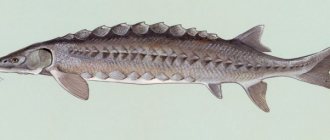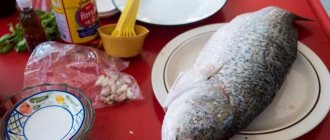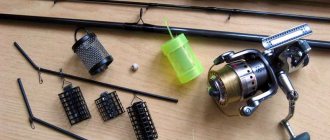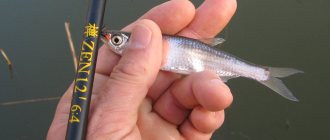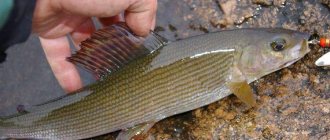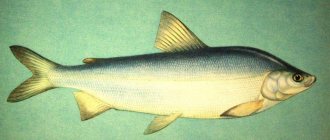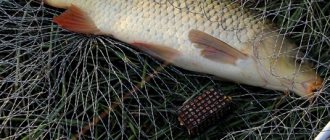How to catch big fish
Greetings , dear readers. The issue of catching large fish is always relevant. Many fishermen successfully catch crucian carp, carp, perch and other fish throughout their lives. But they never manage a trophy specimen They begin to blame the weather, refer to bad luck and lethargy of the fish, and some at this time are carrying large fish.
It turns out that in order to catch big fish you just need to have patience and know a few important nuances .
We will talk about these nuances in this article.
Selecting a location
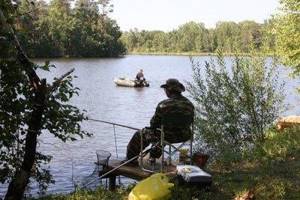
The first thing you need to remember is choosing a location. Large fish are very careful; catching them by throwing them into a random point in a reservoir is very rare, which again reduces your chances of success. To get closer to your target, you need to identify bottom holes or depressions where large fish often feed. Don't know how to determine depth? Here's how to do it using a marker float.
Also, suitable places where large fish can hide are snags and places littered with branches or other shelters. But be careful. In such places, there is a high probability of a big fish biting, but in order to pull it out without breaking, you need good tackle.
If the reservoir is not too large (up to 200 meters wide), and the opposite bank is inaccessible, it is necessary to cast or bring the gear by boat directly under that bank. If there are trees leaning over the water on the other side, then be sure that there are a lot of branches at the bottom in which your gear can get tangled, especially after a bite. To avoid this, you need to lower the bait in the area of 5-10 meters from the shore, on the border between a clean and cluttered bottom. The fish will still be moving around in this area in search of food and when they see your bait they will certainly react to it. But be careful, as soon as the fish grabs the bait, it will immediately rush into these branches and snags, so don’t miss the hook and don’t let the fish hook or break off.
We choose the place wisely
The first thing you should pay attention to is the choice of location. The fact is that large fish behave cautiously and it is very difficult to catch them by throwing the tackle in a random place. It is advisable to examine the bottom of the reservoir and find edges and holes ; in these places there is a high probability of catching a trophy
We recommend: What to do if you fall through the ice
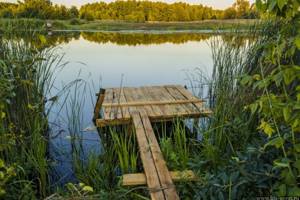
Also promising places are various snags and flooded tree branches .
But be careful, when fishing in such places you risk breaking the equipment, or you need to use good tackle
Feeding
If your goal is the specific capture of a large trophy, then complementary feeding must be present, and there must be quite a lot of it. But don’t be afraid of high expenses right away. You don't have to buy expensive packages of complementary foods in the store. It's easy and inexpensive to make your own complementary foods. To do this, you should buy halva, makukha, ground sunflower seeds, and cheap cereals at the market (where it’s cheaper).
You need to cook at least half a bucket of complementary foods. To save money, store-bought complementary foods should only be added as an additive.
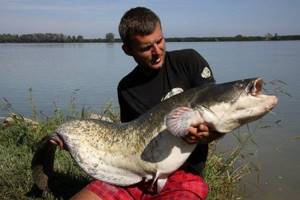
Although the trophy catfish is much larger in size, this specimen also deserves attention
The bait must be brought to the fishing site by boat or thrown using a special fishing slingshot. You should not hope that complementary feeding will immediately show results. A fairly well-fed place in the morning will begin to “work” only in the evening or at nightfall (if not at all the next morning). In this case, complementary foods should be added regularly.
Without the use of complementary foods, it is useless to count on catching a trophy specimen. Rely solely on luck.
Lure
If you really want to catch a big fish, then be sure to use bait, and in large quantities. There is absolutely no need to spend money on store-bought bait.
You can buy cereals, macadamia, ground seeds in a store or at the market and they will make equally catchable bait.
But you shouldn’t expect instant results It often happens that you feed in the morning, but active biting begins only in the evening.
Fishing place

Not every fish can be easily caught anywhere. For example, a quiet pool is considered the habitat of clumsy ides with golden scales: there this individual is able to comfortably settle down near a wooded hillock or hide among dense bushes, opposite a clean and transparent shore.
At first glance, it seems that such a quiet and clean shore is simply ideal for fishing, because in the clear water you can see any fish. However, all ideas about an excellent bite on a clean shore are nothing more than an illusion, and expecting a rich catch in such cases is pointless.
In fact, fish also understand a lot, so when an ide sees a fisherman sitting with a fishing rod, it will most likely simply swim away and not bite in its thirst to become an easy prey.
How to dress and what to take on board
In addition to your favorite fishing tackle and bait, take with you on your trip and on board the boat polarized (reflective sun glare) sunglasses, sun cream with an SPF 50+ filter, and anti-sickness tablets. Don't forget special gloves for fishing large fish - they will protect your hands from calluses.
When fishing, it is better to wear shorts or light trousers made of quick-drying material, a long-sleeved T-shirt, a baseball cap and sports sandals (not flip-flops: this can lead to injuries). There is almost always water and other non-alcoholic drinks on board the boat, and a light lunch is often included in the charter price. However, check in advance what the meals will be and, if necessary, bring a lunchbox with you.
You should not try to photograph trophies or the fishing process with your phone - it may go overboard. It’s better to take a GoPro camera with a head-mount on your trip.
Don't try to persuade family members or friends to go out to sea with you if they don't fish. Without being involved in the fishing process, they will quickly get bored, or even feel symptoms of seasickness, and you will no longer have time for fishing.
Bait
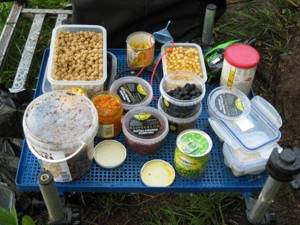
To catch large fish, you will have to weed out small bites using bait. To do this, you need to choose a bait that will be too tough for small fish. Such bait can serve as:
- corn (1-5 grains per hook);
- peas (1-5 peas per hook)
- the worm crawls out (whole, or at worst half);
- pearl barley (also a few grains per hook).
- boilies;
- frog (in case of catching catfish).
Please note that in order to really catch big fish you will need high-quality large hooks. No. 10 is quite a suitable option. Put on so many grains of bait at once that it is almost completely filled, just leave a little space (about one pea) so that when a large fish bites, the bait has somewhere to move and free up the sting for the fish to hook. If the bait is quite hard and the fish may not pierce it to the point of the hook when biting, you can leave the point bare, literally 1-3 mm, or pierce the bait and hide the point back into it.
The best way to catch large fish is to use a tackle with a hair on which the bait is placed, while the hook remains free and the fish is hooked on its own.
Tips for fishermen: what fish bite best?
Seasoned and experienced fishermen have their own secrets of luring and catching fish. Our tips are intended for beginner fishing enthusiasts. And also for those who only occasionally pick up a fishing rod when going out into nature with friends. We will tell you which bait fish bite best.
1. Crucian carp
As complementary food, you can use pearl barley porridge with a viscous consistency, mixing it with ground bread crumbs. A wide variety of bait is used for catching crucian carp: it can be worms, steeply kneaded dough, bread crumb (rolled into a ball). There is one small but very effective secret: crucian carp really loves the smell of dill. Therefore, add a little dill oil or crushed dill seeds to complementary foods or to a bread pellet (if that is what you put on the hook).
2. Perch
Small perch (fishermen call it “sailor” or “grassfish”) can be caught near the shore with a fishing rod or other light tackle, and bloodworms or worms can be used as bait. Large perch (“humpbackfish”) live in the depths, so it is preferable to catch them from a boat. Spoons, poppers, artificial flies, etc. are used as bait. The humpback fish bites especially well on small live bait, although a worm can also be used.
3. Chub
This fish can be caught throughout the day, but the best bite is at dawn (morning and evening). The float should be used in a discreet color (gray, black, brown), since bright colors scare away the chub. The fish bites well on earthworms (earthworms or rossoviki), on the larvae of dung beetles and May beetles. You can hook caterpillars and even small minnows. In the summer, chub are also caught using dough and bread pellets.
4. Tench
This fish loves silted areas of the reservoir, as well as places overgrown with mud and reeds. Tench often approaches the very shore, where it can be caught at shallow depths. Earthworms are best suited as bait, but sometimes fish get picky and bite better on maggots, bloodworms or bread balls with anise.
5. Bream
In spring and summer, fish approach the coastal zone with a depth of two meters. In winter, bream can only be caught in deep-water areas of reservoirs (six meters or more). To lure fish to the fishing spot, they use various baits, both purchased and homemade. The main ingredients of homemade baits are cake (sunflower, pumpkin, flax seeds), crushed oatmeal or ground peas, breadcrumbs and essential oils. Worms, bloodworms, maggots and dough are used as bait. Sometimes fish even bite on pearl barley and canned corn.
6. Pike perch
In the spring, pike perch can be caught in flowing reservoirs on shallows located next to holes and pools. In summer, this fish goes deeper. Depending on the water temperature, it may approach shallow waters or remain in areas with bottom depressions. Excellent bait for pike perch are silicone fish, oscillating spoons, live fry or a bunch of worms.
7. Carp
This fish lives in almost all fresh water bodies. In spring, carp go to the shallows, and with the onset of heat, they prefer shady and deep areas of the river (lake, pond). To feed the fish, use various cake mixtures and porridges, mashed potatoes or purchased fish feed. The fish is voracious, so it is almost impossible to overfeed it. Carp bite on worms, maggots, bread, green peas, corn and boilies.
8. Roach
This fish is also called roach, ram, sorozhka or chebak. The roach lives in reservoirs with a quiet current and loves places with rich aquatic vegetation. Before fishing, you need to lightly feed the fish. Mixtures consisting of food bloodworms and soil taken from the shore of a reservoir have proven themselves well in this regard. You can also use grain bran, breadcrumbs, and cake as the main ingredients. The best baits are a worm, maggot, and kazara (dragonfly larva). Roaches also bite on bread crumbs, dough, pearl barley, and steamed wheat grains.
9. Pike
The toothed predator prefers to hunt from ambush, so you need to catch it in places where it can hide. These include areas with uneven bottom surfaces, areas near fallen trees or flooded bushes, and the interface between grassy areas and clear water. Pike are caught using silicone and foam baits and spinners. But it is best to use live bait - gudgeon, roach, bleak. Small fish can be caught with a worm.
Similar
Dictionary
Fishing is the process of removing fish from the water from the moment it bites.
Wake is a trace on the water that a ship leaves when moving.
Tackle - attaching dead or live bait to a hook.
Spinning is a rod with a reel and fishing line.
Spinner is a metal imitation of fish used as bait.
Plumb fishing - fishing from a stationary boat using heavy artificial bait.
Fly fishing is fishing using a special rod and line using artificial bait.
American surfer Cassia Meador with her trophies caught in the waters of the Mexican city of Zihuateanejo: mackerel and tuna
Depth sounding
Oddly enough, on steep river edges it was most difficult to decide on the tactics for feeding fish.
However, after participating several times in fishing competitions with a float rod, I made several important discoveries for myself. Almost all competitions are held on embankments and dams that have a significant slope. Tens of kilograms of bait are thrown into the water at a time. It would seem that fish should come running to such a feast from all over the reservoir, but that’s not the case. Some athletes catch fish consistently, others only participate in the crowd. And the main reason for the lack of bite is the illiterate use of bait, which safely rolls down the slope of the dam, and the fish follow it.
On amateur fishing, everything happens approximately the same.

